05 Jun India’s Green Renaissance: Leading the Way in Environmental Transformation
This article covers “Daily Current Affairs” and the Topic of India’s Green Renaissance: Leading the Way in Environmental Transformation
SYLLABUS MAPPING:
GS-3- Envionment- India’s Green Renaissance: Leading the Way in Environmental Transformation
FOR PRELIMS
What is the importance of World Environment Day? How is India contributing to this cause?
FOR MAINS
What is the role of people in protecting the environment? How is the Indian government encouraging public participation?
Why in the News?
Plastic pollution has once again come into global focus with the theme of World Environment Day 2025 being “Combating Plastic Pollution”, highlighting the urgent need for coordinated international action. This continues a consistent emphasis by the United Nations over the past seven years, including previous themes such as ‘Beating Plastic Pollution’ (2018) and ‘Ridding the Environment of Plastic’ (2023). World leaders and environmental bodies now acknowledge the severity of the crisis, with growing consensus on the necessity of a legally binding global treaty to curb plastic pollution across its life cycle—from production to disposal.
A Climate Champion On The World Stage
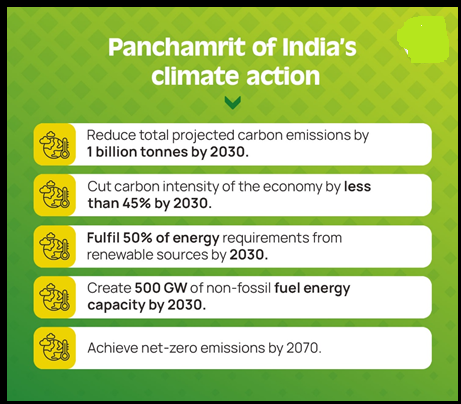
In 2014, India was seen as a hesitant participant in global climate talks. That changed as Government brought in the concepts of climate justice and equity, reshaping the global climate narrative.
1. At COP21 (Conference of Parties 21) in Paris, India pledged to achieve 40% of its installed electricity capacity from non-fossil fuel sources by 2030; a goal met ahead of time in November 2021.
2. At COP26 in Glasgow, PM Modi launched LiFE (Lifestyle for Environment), encouraging sustainable habits and promoting mindful consumption over wasteful use. India also introduced the Panchamrit, which has five key targets for climate action.
3. At COP29 in Baku (Nov 2024), India showcased its progress in climate adaptation and clean energy through global partnerships. Sessions focused on disaster-resilient infrastructure, industrial decarbonization, solar energy, and women-led climate action, in collaboration with Sweden, CDRI (Coalition for Disaster Resilient Infrastructure), ISA (International Solar Alliance) and NRDC (Natural Resources Defense Council).
How Indias transforming
1. India’s Clean Energy Progress: In FY 2024–25, India added a record 29.52 GW of renewable energy capacity, increasing the total installed capacity to 220.10 GW, up from 198.75 GW in FY 2023–24. This marks strong progress toward the 500 GW non-fossil fuel target by 2030.
2. Solar Energy: India’s solar energy installed capacity saw a 25.46-fold increase, rising from 2.82 GW in 2014 to 71.78 GW in April 2025. Solar tariffs dropped by 65%, from ₹6.17/kWh in 2014–15 to ₹2.15/kWh in 2024–25, making them the lowest in the world.
3. Wind Energy: Wind energy capacity grew 2.38 times, from 21.04 GW in March 2014 to 50.04 GW in March 2025. The government has set a target of achieving 140 GW of wind power capacity by 2030.
4. Nuclear Energy: Nuclear energy capacity has seen an 84% increase since 2014, rising from 4.78 GW to 8.78 GW in 2025. The government has set an ambitious target of 100 GW of nuclear power capacity by 2047.
Global Recognition
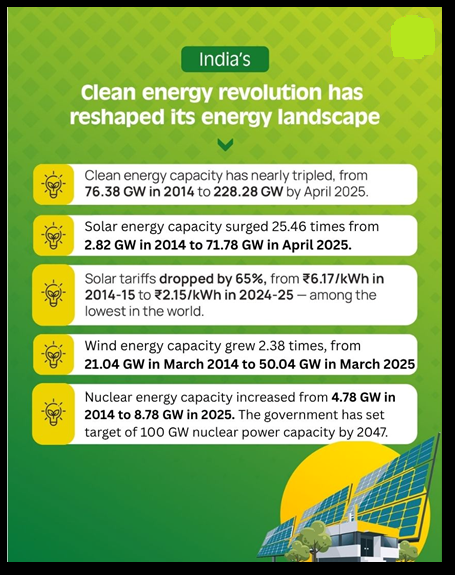
Flagship Initiatives for a Sustainable Future
1. International Solar Alliance (ISA): Launched by India and France at COP21 in 2015, ISA is a global platform promoting solar energy for energy access and climate action. Headquartered in India, it has 105 member countries and aims to mobilise $1 trillion in solar investments by 2030.
2. National Green Hydrogen Mission:
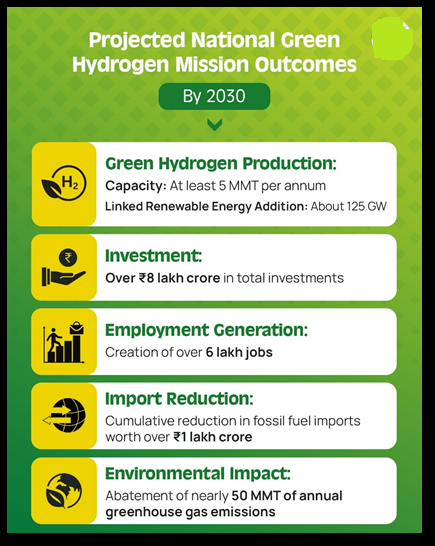
Launched in January 2023, the mission aims to make India a global hub for green hydrogen production and export. It targets 5 MMT annual capacity by 2030, with over ₹8 lakh crore in investments, creation of 6 lakh jobs and reduced fossil fuel dependence.
3. PM Surya Ghar: Muft Bijli Yojana (PMSGMBY)
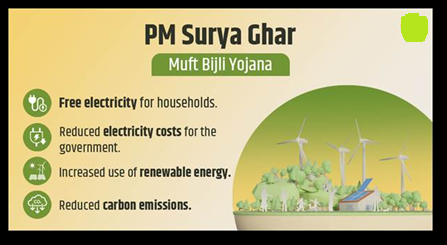
Launched by Prime Minister Narendra Modi on February 15, 2024, PMSGMBY is the world’s largest domestic rooftop solar initiative. Focused on benefiting low-income households, the scheme has already brought rooftop solar to 11.88 lakh homes till April 2025. A dedicated digital platform ensures easy access to subsidies and loans, making clean energy adoption more accessible and efficient.
4. Model Solar Village | A Key Component of PM Surya Ghar Muft Bijli Yojana: Under this major component, one solar-powered model village will be developed in every district to promote decentralized solar adoption and rural energy self-reliance. With a total outlay of ₹800 crore, each selected village receives ₹1 crore in Central Financial Assistance. Eligible villages must be revenue villages with populations over 5,000 (or 2,000 in special category states).
5. PM-KUSUM (Pradhan Mantri Kisan Urja Suraksha evam Utthaan Mahabhiyan) Scheme: Launched in March 2019, the PM-KUSUM scheme promotes solar energy in agriculture by supporting solar-powered irrigation systems. It offers 30% to 50% central subsidy for new solar pumps and solarising existing ones.
6. UJALA Scheme (Unnat Jyoti by Affordable LEDs for All): Launched on 5th January 2015 by Prime Minister Narendra Modi, UJALA (Unnat Jyoti by Affordable LEDs for All) promotes energy efficiency by distributing LED bulbs, tube lights, and fans. Initially called DELP (Domestic Efficient Lighting Programme), the scheme has helped reduce electricity consumption and made sustainable lighting affordable for millions.
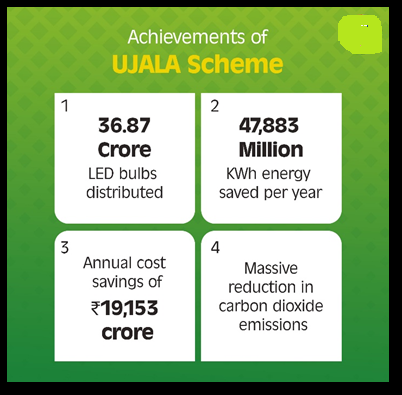
Conservation And Wildlife Protection: Nature Strikes Back
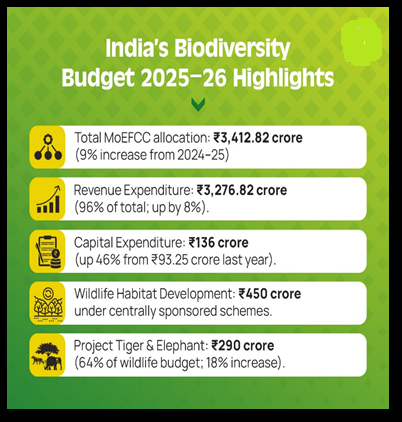
Preserving the environment requires more than just schemes, it needs strong funding, effective implementation, and community participation. India, one of the world’s most biodiverse countries, is taking key budgetary steps to support conservation.
1. Biodiversity Richness: Though covering just 2.4% of Earth’s land, India hosts 7–8% of global species, including 45,000+ plants and 91,000+ animals.
2. Biodiversity Hotspots: India includes 4 major global hotspots; the Himalayas, Western Ghats, Northeast, and Nicobar Islands.
3. Tiger population more than doubled: As per the 5th cycle of the All India Tiger Estimation 2022 (usually done in cycles of four years) summary report, India has a minimum of 3682 tigers and is now home to more than 75% of the world’s wild tiger population.
4. Project Cheetah: Project Cheetah is the world’s first inter-continental large wild carnivore translocation project. It aims to reintroduce cheetahs in India after their extinction, restoring ecological balance and boosting biodiversity. Under Project Cheetah, Prime Minister Narendra Modi released eight wild cheetahs brought from Namibia into Kuno National Park on 17th September 2022.
5. Project Lion: Project Lion was announced on August 15, 2020 as a major step to ensure the long-term conservation of the Asiatic lion. This initiative focuses on habitat development, disease control, and a dedicated lion conservation breeding program.
6. Palli in J&K became India’s first carbon-neutral panchayat: Under the revamped National Panchayat Awards in 2023, Ministry of Panchayati Raj has instituted ‘Carbon Neutral Vishesh Panchayat Puraskar’ to award Panchayats for exemplary work towards achieving Net-Zero carbon emission.
7. The “Ek Ped Maa Ke Naam” campaign has seen the planting of over 142 crore trees: On the occasion of World Environment Day, Prime Minister Narendra Modi launched the ‘Ek Ped Maa Ke Naam’ campaign, a unique initiative combining environmental responsibility with a heartfelt tribute to mothers. This campaign was inaugurated on June 5, 2024, with the planting of a Peepal tree by the Prime Minister at Buddha Jayanti Park in Delhi.
8. Ramsar Sites in the country stands at 85: India is a Contracting Party to the Ramsar Convention, signed in 1971 in Ramsar, Iran. India joined the convention on 1st February 1982. From 1982 to 2013, 26 wetlands were designated as Ramsar sites. Between 2014 and 2024, India added 59 more sites. As of 2024, the total number of Ramsar sites in the country stands at 85. This shows India’s growing focus on wetland conservation.
The Namami Gange Mission: A Holy Transformation
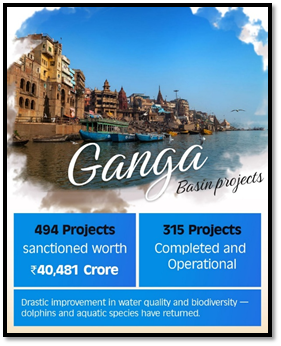
1. Clean Villages, Circular Economy: India has achieved new milestones through the Swachh Bharat Mission and GOBARdhan. The mission promotes sustainable waste-to-wealth solutions, driving cleaner and healthier communities nationwide.
2. Swachh Bharat Mission (Urban): The Swachh Bharat Mission-Urban (SBM-U) was launched on October 2, 2014, to address urban garbage, waste, and sewage issues. SBM-U 2.0 started on October 1, 2021, aiming for safe sanitation and scientific municipal solid waste management by 2026
3. Swachh Bharat Mission (Grameen) [SBM(G)]: SBM (G) was launched on October 2, 2014, to achieve Open Defecation Free (ODF) status in rural India. By 2019, sanitation coverage rose from 39% to 100%, with 12 crore toilets built, improving health and hygiene. Phase II, started in 2020, focuses on ODF sustainability and waste management, aiming for ODF Plus by 2025-26.
What are the issue where india is lacking
1. Plastic Waste Management: Despite bans, single-use plastics persist due to weak enforcement and lack of cost-effective alternatives. Segregation and recycling rates remain low.
2. Air Pollution: Many Indian cities rank among the world’s most polluted. Measures like the National Clean Air Programme suffer from poor monitoring and slow implementation.
3. Deforestation and Land Degradation: Development projects often lead to forest loss. Around 30% of India’s land is degraded, affecting agriculture and livelihoods.
4. Water Pollution and Overuse: Rivers remain polluted despite clean-up missions. Overextraction of groundwater has led to alarming depletion in many regions.
5. Coal Dependency and Energy Transition Gaps: Coal still dominates power generation. Challenges remain in renewable energy storage, grid integration, and clean energy access for all.
6. Underfunded Climate Adaptation: Focus is more on mitigation than on supporting vulnerable populations against climate impacts like floods, droughts, and cyclones.
7. Biodiversity and Habitat Loss: Human-wildlife conflicts, poaching, and fragmented habitats continue. Community involvement in conservation is often lacking.
8. Urban Waste and E-waste Management: Scientific waste disposal systems are inadequate in many cities. E-waste and biomedical waste pose growing health and environmental risks.
Way forward
1. Strengthen Implementation & Monitoring: Ensure strict enforcement of environmental laws and better inter-agency coordination. Fast-track execution of clean energy and waste management projects.
2. Boost Circular Economy: Promote recycling, reuse, and eco-design, especially in plastic and e-waste sectors. Support innovation in biodegradable alternatives.
3. Accelerate Renewable Energy Transition: Invest in energy storage, smart grids, and green hydrogen. Ensure affordable and reliable clean energy access for all, including remote areas.
4. Improve Air and Water Quality: Scale up urban air quality monitoring, clean mobility adoption, and river rejuvenation efforts like Namami Gange with stricter pollution control norms.
5. Focus on Climate Adaptation: Allocate more funds for climate-resilient infrastructure, early warning systems, and livelihood protection in vulnerable regions.
6. Empower Local Governance and Communities: Involve Panchayats, civil society, and youth in grassroots conservation, afforestation, and water management.
7. Enhance Environmental Education: Promote environmental awareness in schools and through campaigns like LiFE to build sustainable lifestyles and informed citizen participation.
8. Strengthen Biodiversity Protection: Expand protected areas, invest in wildlife corridors, and incentivise community-led eco-tourism and conservation efforts.
Conclusion
As PM Modi aptly put it, “Our planet is one, but our efforts must be many.” India’s 11-year journey proves that sustainable development is not a distant dream but a vibrant, achievable reality. From the deep cleaning of the Ganga to becoming a global renewable energy giant, and from reviving cheetahs to energizing villages with solar power, India is scripting a new ecological narrative one that blends heritage with innovation, local action with global leadership and vision with relentless execution. India’s green transformation is not just a policy shift. It is a people’s movement, a planetary commitment, and a promise to future generations.
Download Plutus IAS Current Affairs (Eng) 5th June 2025
Prelims Questions
Q. Which of the following statements about India’s environmental initiatives is/are correct?
1. The “LiFE” movement launched at COP26 promotes sustainable lifestyles and conscious consumption.
2. The PM Surya Ghar: Muft Bijli Yojana is aimed at industrial solar energy expansion.
3. Project Cheetah aims to reintroduce extinct species into Indian ecosystems.
4. India currently hosts over 85 Ramsar sites as of 2024.
Select the correct answer using the code below:
(a). 1 and 2 only
(b). 1, 3 and 4 only
(c). 2 and 3 only
(d). 1, 2, 3 and 4
Answer: B
Mains Questions
Q. India has transitioned from a hesitant participant to a global leader in environmental and climate action. Discuss the major initiatives taken by India in recent years for promoting sustainability, clean energy, and biodiversity conservation. Also highlight the key challenges that still persist and suggest a way forward.
(250 words, 15 marks)




No Comments